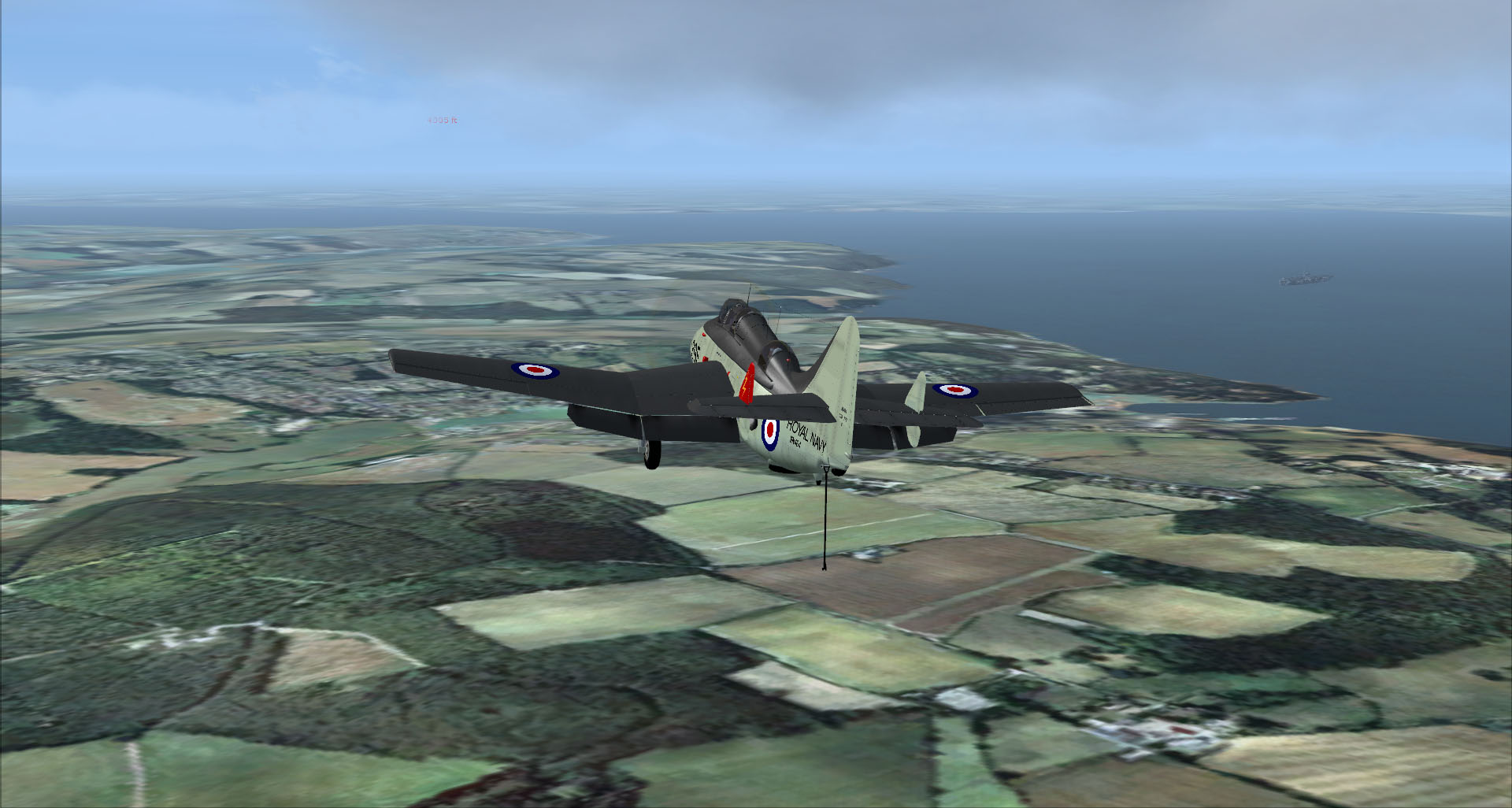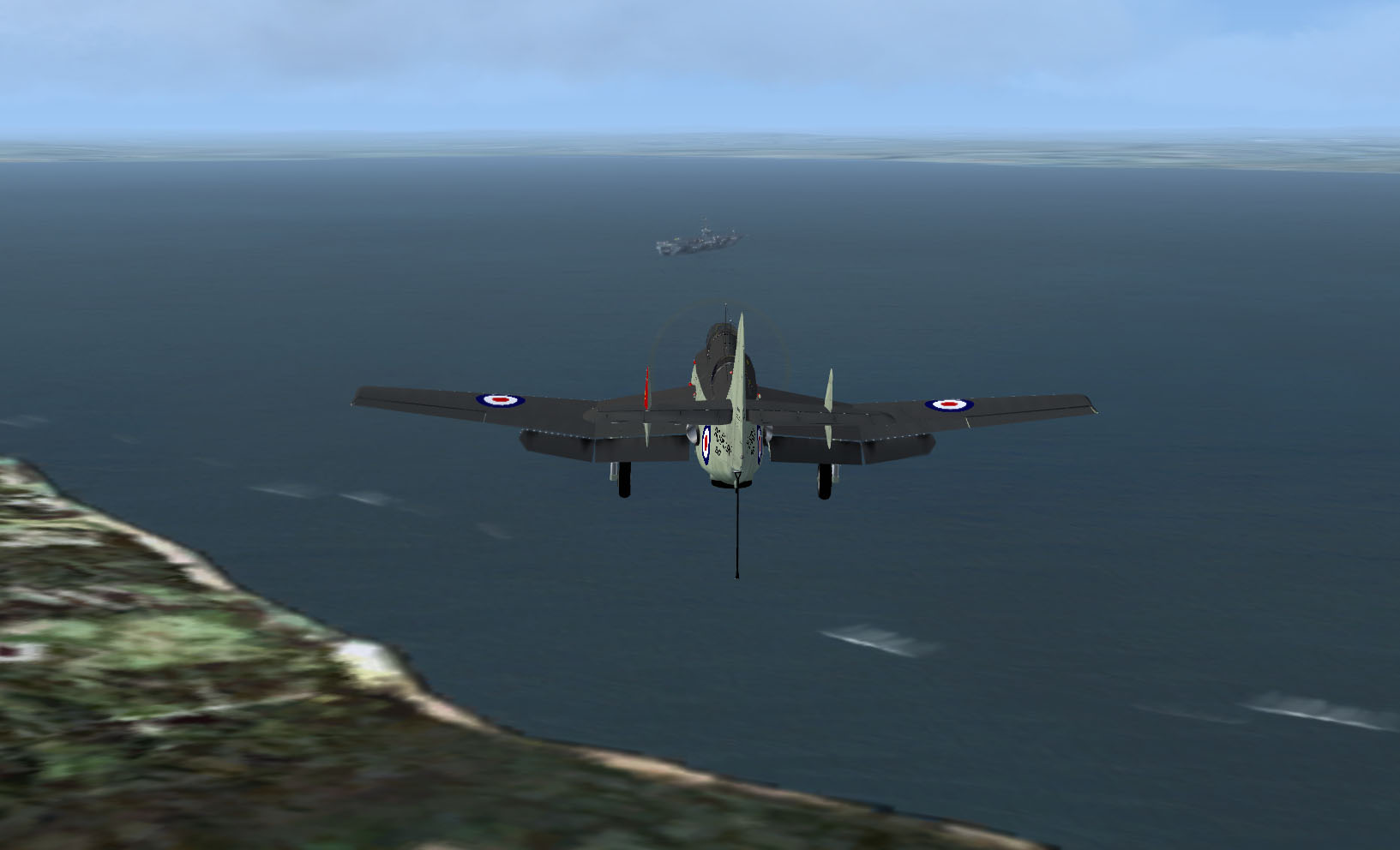IMPORTANT - You cannot access the nearby WAYPOINTS from the Lamont Clark AIcarriers menu UNTIL you have displayed, the GPS from your aircraft you are in at least once, (you can close it straight after opening) - This initialises the nearby WAYPOINTS. Once per FSX session is enough to ensure they appear in the menu.
Remember the secret to any good landing is a planned approach. The carriers have the BRITISH invented visual light landing assistance so position yourself at about 2000ft about 10 miles behind and slightly to the right of the carrier because you are landing on another BRITISH invention the ‘ANGLED DECK’ very handy as the carrier does not run you over if you go over the edge, plus it leaves the forward carrier deck clear to launch aircraft while recovering aircraft. Pretty neat huh.

After taking off from Bembridge on the Isle of Wight the Gannet is on a long base leg looking for 'Wotton Creek' to mark a turn on to long 'finals' for the deck of Nimitz which can be seen as a small dark line above and to the right of the right (starboard) wing tip.

Finals for the Nimitz - Gear down, hook down, flaps deployed, check speed adjust power, check decent rate. Pass over the coast at about 800 feet configured to land with speed at about 90 knts nice and stable so you can concentrate on landing.
In real life a carrier will turn into wind, then make the best possible speed into that wind before launching or recovering aircraft. With this stationary aircraft carrier, making a good landing or falling into the water soon after launching may not be your fault!! Check the wind direction and speed by selecting the <Map> option and looking at the little arrow with figures something like this - 180/30kts - These numbers are the wind direction and speed, which change as the weather changes if you have selected real world weather. In the case above with a 30 knot southerly wind, ( 180/30kts), if you try to land on a carrier with it's bow facing north then effectively you are landing with a tailwind making your speed over the landing deck threshold not say the normal 130 knots, but more 160 knots. In a crosswind situation this could be even harder. So if you are finding things difficult check your weather.. Checking the weather before you fly is a good habit to get into. In an ideal situation with the carrier making 20 knots into a 30 knots headwind then your landing speed is reduced by 50 knots, so an approach at an indicated 130 knots, means contact with the deck at 80 knots - a much better and safer option.
1 All landings are made from the back, (stern) of the aircraft carrier with the tower bit superstucture (the Island) always on your right hand side (starboard).
2 You need a carrierborne aircraft, although with practice I have landed a C130. No that’s not silly the USA actually did this to test replenishment at sea (Carrier Onboard Delivery or COD in the UK), with a C130F landing on both the axial line deck and the angled deck although with a lighter load. If you want to see it have a look on YouTube here.
https://www.youtube.com/watch?v=0hvo-vdxJqw
These landings were made UN-ARRESTED and the take offs UN-CATAPULTED. Using a carrier can give you a real life appreciation of the dramatic way weight affects performance and in aircraft more IMPORTANTLY how the change in the CENTRE OF GRAVITY affects flight. I only weigh about 8 stone, 120 lbs so with not much weight forward I make sure I do not get tail heavy by letting very large ppl sit in the very back seats - be tactful. Imagine the aircraft centre of gravity as a tennis ball that must not stray outside the handbook limits.
More than one pilot (including a friend of mine) has entered a 'flat spin' because they neglected to do the math before flight. Weight and its distribution is something not often thought about when using FSX. (Don’t cheat by not loading enough fuel to make an alterative landing).
Many other non carrier aircraft can, with care be landed unarrested and take off without a catapult launch from a carrier deck using the longer 'axial' runway instead of the 'angled deck' runway. Aircraft such as the Cessna 150, 172, the Cessna caravan (turbine powed) using reverse thrust and brake quick enough (remember not many aircraft are cleared for reverse thrust (F2) in flight.
STOL aircraft like the Pilatus Porter even the Twin otter will perform well with practice.
Please don’t give up and resort to fiddling with your files, that’s rather silly now isn't it and you know you are only fooling yourself.
Personally if I had to do this for real I would go for a normal prop engine with plenty of HP with a variable pitch propellor as the throttle response is immediate The fast prop spinup of a piston engine gives you a lot of 'air wash' on your rudder and elevators, so you get crisp response. Jets and prop jets - turboprops on the other hand require more fore thought as they have a definite 'lag' between throttle application and 'spin up' and desired result. The method with lots of turbine HP would be to overcome imposed drag with the spare HP that these engines are capable of delivering. Do not make any major throttle changes close to the sea though because the lag wil get you every time. Tail draggers make landing and take off a little more difficult as you really need to see the deck all the time.
3 Lower the hook with <SHIFT+Q>
4 Lower all your flap in stages increase power to counteract drag
5 Get in the glide path ‘groove’ for a green light
http://en.wikipedia.org/wiki/Optical_Landing_System
6 Cut power only if you catch the hook in case miss hook.
7 If you don’t catch then full power is already there to so climb out very very slowly decrease flaps in small stages. Remember a stage of flap up can dump you 100 feet quicker than that. Far better to have some positive climbout than be sinking.
8 Do a left hand 1000ft circuit and try again. Circuits are 600 to 800 feet really, only 1000 or 2000 gives a better result in FSX more time to think.
9 Remember an aircrafts landing all up weight is less than you think. Very often you are not safe to land on the same runway you just took off from. If if you have trouble consider unloading some fuel and or weapons before attempting to land. Found in <Fuel and Payload>.
If you get stuck ask me and I will try to help you. Here are some handy keyboard sequences to make things happen. The + means hold first key down while pressing the second key. (Yes I know).